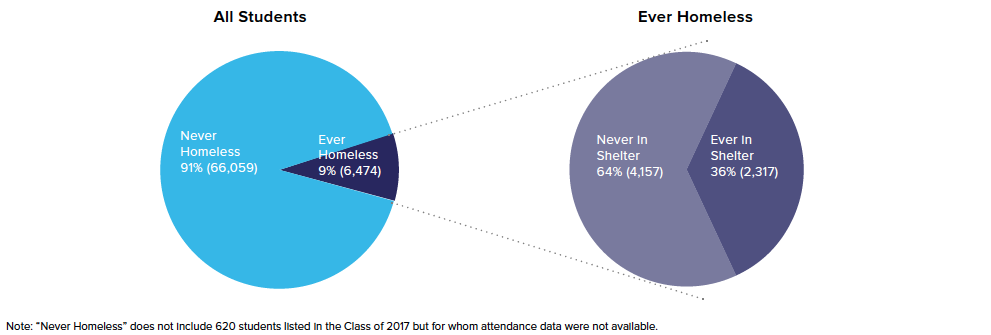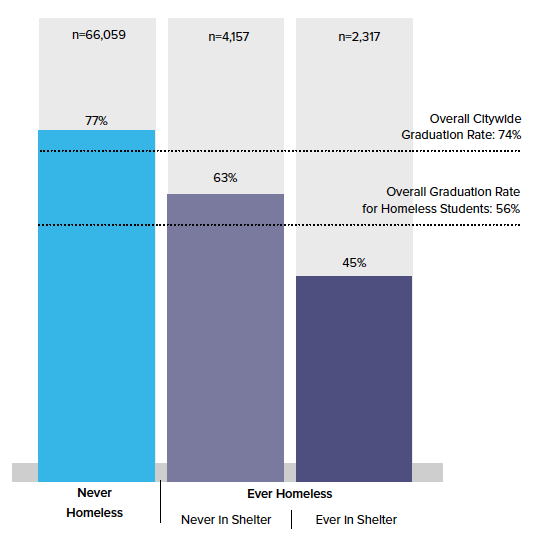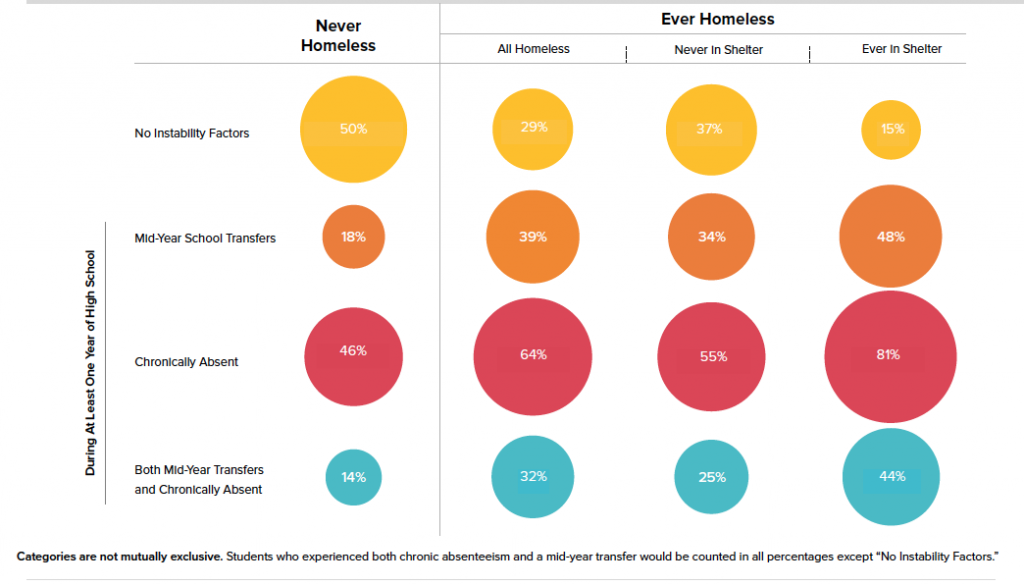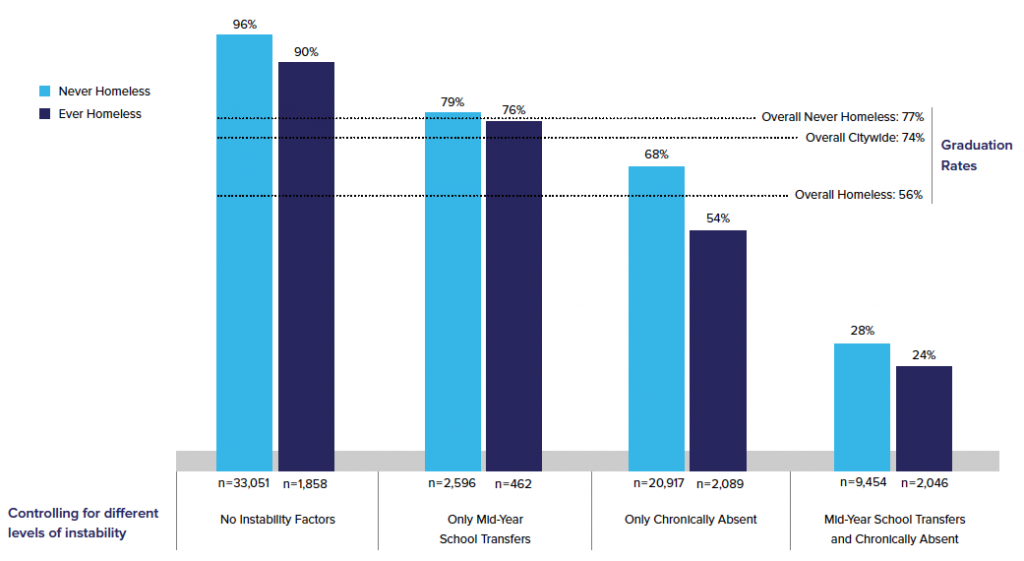December 2018
Homeless high school students who are not chronically absent and who do not transfer schools during the year graduate at rates similar to their housed peers.
Overview
High school graduation is key to breaking the cycle of homelessness and ensuring access to opportunity for all students. While four-year graduation rates in New York City have increased, from less than half of students graduating in 2005 to almost three-quarters in 2017, homeless students still graduate at substantially lower rates than their housed classmates. Yet analysis of New York City Department of Education (DOE) data shows that when students experiencing homelessness maintain stability in school, they graduate at similar rates to their housed peers. This report presents data on the four-year high school graduation rate of New York City’s Class of 2017—those who were high school freshmen in SY 2013–14 and on track to graduate on time. The impacts of housing instability, mid-year school transfers, and chronic absenteeism on four-year high school graduation rates are explored, and the importance of maintaining school stability while experiencing homelessness is discussed.
What Percent of Students Were Homeless At Some Point During High School?
Class of 2017
Almost 10% of students who were in the class of 2017 were “ever homeless,” meaning they had been identified as homeless during at least one of their four years of high school.
Nearly one in every 10 graduates of New York City public schools in 2017 had experienced homelessness at some point during high school. Of those, almost two-thirds of homeless students had never been in shelter, but lived in doubled-up or other temporary living arrangements. The remaining one-third of homeless students lived in a shelter at some point during high school.

How Do Graduation Rates Compare Between Students Who Have Never Experienced Homelessness and Those Who Have, in a Shelter or Elsewhere?
Class of 2017
Students who experienced homelessness at least once during high school were less likely to graduate on time than those who never experienced homelessness. Among students who were ever homeless, those who stayed in shelter at least once during high school were less likely to graduate on time than those who were homeless but were never in shelter.

Never Homeless:
Students who lived in stable housing all four years of high school.
Ever Homeless:
Students who experienced homelessness at some point during four years of high school.
Never in Shelter:
Students who experienced homelessness at some point during high school but never lived in a shelter, and instead lived doubled up with friends or family, in other temporary arrangements, or somewhere not meant for human habitation.
Ever in Shelter:
Students who experienced homelessness at some point during high school and lived in a City-funded or operated facility, including Tier II shelters, hotels, and cluster sites.
Although the exact duration of a student’s homelessness is unknown, even a brief experience with housing instability, especially in shelters, can put students at risk of not graduating. Services to students vary widely within the shelter system, but a lack or limitation of support services and/or a distant shelter location can make it difficult for students living in shelter to get to school. As a result, homeless students may end up missing more days of school and transferring schools more often.
- Citywide, 74% of all New York City high school students graduated on time in 2017, and rates were even higher (77%) among students who were never identified as homeless during high school. Of students who had been identified as homeless, however, only 56% graduated on time.
- Among homeless students, 63% of students who never stayed in a shelter graduated on time. Nearly two-thirds (64%) of students who experienced homelessness at some point during high school never stayed in shelter, but rather stayed in other temporary arrangements.
- Less than half (45%) of homeless students who lived in a shelter at any point during high school graduated on time. This rate was significantly lower than the 56% rate for all homeless students, and less than two-thirds the 74% rate for all students.
How Prevalent Are School Instability Factors Among Students Who Have Never Experienced Homelessness Compared to Those Who Have?
Class of 2017
Homeless students experienced instability factors such as mid-year transfers and chronic absenteeism (missing more than 10% or 18 days of a single school year) more often than their never-homeless peers. Students who were ever in shelter were the most likely to experience any type of instability.

- Homeless students were much more likely to experience instability factors such as midyear school transfers and chronic absenteeism. Less than a third (29%) of homeless students experienced neither of these instability factors, compared to half (50%) of students who were never homeless during high school.
- Compared to their never-homeless classmates, students who experienced homelessness were more than twice as likely to have changed schools mid-year at some point during high school (39% vs. 18%) and more likely to be chronically absent (64% vs. 46%).
- Nearly one-third (32%) of homeless students experienced both a transfer and chronic absenteeism during their four years of high school. This rate was more than double the 14% of never-homeless students who had experienced both instability factors.
- Among homeless students, those who had stayed in a shelter were more likely to have experienced an instability factor during high school. Only 15% of these students experienced neither a mid-year transfer nor chronic absenteeism, compared to 37% of their peers who were never in shelter.
- Homeless students who were ever in shelter during high school were more likely than their never in shelter homeless classmates to have experienced mid-year transfers (48% vs. 34%) and more likely to have been chronically absent (81% vs. 55%) during at least one of their four high school years.
- Students who had stayed in shelter during high school were more likely than other homeless students to have experienced both instability factors. Of students who had stayed in shelter at some point during their high school years, 44% had both transferred schools and been chronically absent, compared to 25% of homeless students who had never been in shelter.
How Are Students Distributed Across the Different Instability Categories?
Class of 2017
When there are no instability factors present, all students regardless of housing status graduated at rates of at least 90%, far higher than the citywide average of 74%. However, the majority (71%) of homeless students experienced at least one instability factor compared to only half (50%) of their never-homeless peers.

How Do School Instability Factors Affect Graduation Rates?
Class of 2017
Instability factors negatively affect graduation rates for all students, regardless of whether they experienced homelessness or not. Students who experienced both mid-year school transfers and chronic absenteeism were approximately 3.5 times less likely to graduate on time than those who had not experienced either of these two instability factors.

- Although school instability factors affect the graduation outcomes of all students similarly, students who had experienced homelessness were more likely to experience both instability factors and less likely to have no instability factors. When instability factors are viewed as mutually exclusive categories, less than one-third (29%) experienced no instability during high school, compared to 50% of their never-homeless peers.
- For students who transferred but were never chronically absent, graduation rates were very close to citywide averages. Among homeless students, 76% of students graduated on time, only slightly less than the 79% of never-homeless students—though less than 1 in 10 (7%) homeless students experienced a transfer without also being chronically absent.
- The combined impact of mid-year transfers and chronic absenteeism was substantial. Less than one-quarter (24%) of homeless students who transferred schools mid-year and were chronically absent graduated. Although rates were similarly low (28%) for never-homeless students, homeless students were more than twice as likely to fall in this category (32% vs. 14%).
- Chronic absenteeism was more strongly associated with lower graduation rates for homeless students than their never-homeless peers. Roughly one-third (32%) of both homeless and never-homeless students experienced chronic absenteeism without an additional instability factor, but only half (54%) of homeless students graduated on time, fourteen percentage points below the rate for chronically absent but never-homeless students (68%).
Conclusion
Homeless high school students face many disadvantages as they enter adulthood, but lacking a high school diploma should not be one of them. As this report demonstrates, homeless students who experience no school instability factors, meaning they do not transfer schools during the year and they are not chronically absent, will graduate at levels significantly higher than the 74% citywide graduation rate and almost equal to their never-homeless classmates (90% vs. 96%). Unfortunately, two in every three homeless students experience at least one of these instability factors, compared to just half of their never-homeless peers.
Homeless students who stayed in shelter at some point during high school were more likely to experience chronic absenteeism and mid-year transfers, and less likely to graduate than students in other temporary arrangements. This is in part attributable to the uniqueness of the New York City shelter system, including the high demand for shelter, the City’s right-to-shelter policy, shelter capacity issues, and intake policies. This report is the beginning of a roadmap for developing locally tailored policies and, in the case of New York City, targeting resources to shelter-based programs. Specifically, the City should examine the effects its shelter capacity and intake policies have on homeless high school students. More can be done to ensure students are placed in shelters as close as possible to their schools and are given adequate transportation assistance and academic supports.
New York City DOE data show that closing the graduation gap is possible. With proper connection to services, high school students experiencing homelessness can graduate to a future that has not been hindered by their housing status.
Ralph da Costa Nunez, PhD, President and CEO
Aurora Zepeda, Chief Operating Officer
Policy Team:
Andrea Pizano, Chief of Staff
Josef Kannegaard, Principal Policy Analyst
Chloe Stein, Senior Policy Analyst
Rachel Barth, Policy Analyst
Alexander Tucciarone, Director of Communications and External Affairs
Hellen Gaudence, Graphic Designer
Marcela Szwarc, Graphic Designer